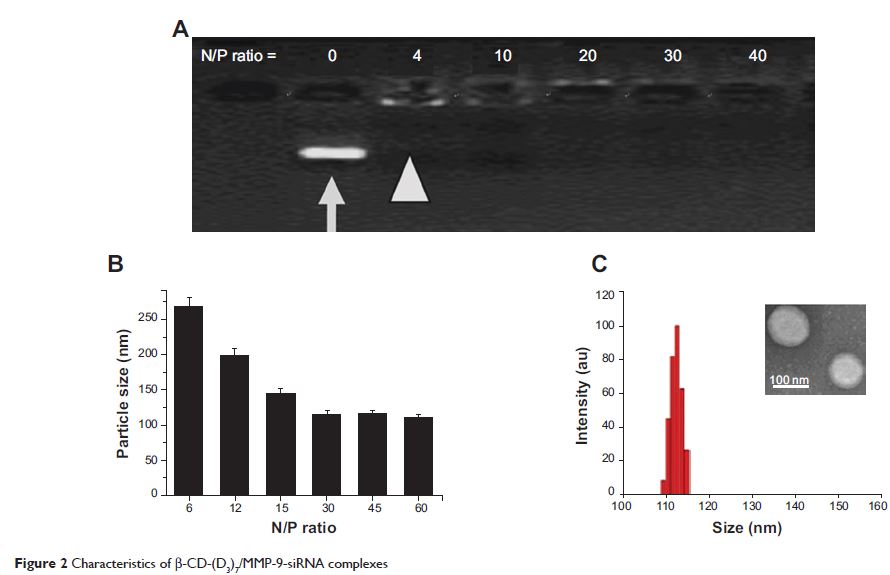109229
论文已发表
注册即可获取德孚的最新动态
IF 收录期刊
- 3.4 Breast Cancer (Dove Med Press)
- 3.2 Clin Epidemiol
- 2.6 Cancer Manag Res
- 2.9 Infect Drug Resist
- 3.7 Clin Interv Aging
- 5.1 Drug Des Dev Ther
- 3.1 Int J Chronic Obstr
- 6.6 Int J Nanomed
- 2.6 Int J Women's Health
- 2.9 Neuropsych Dis Treat
- 2.8 OncoTargets Ther
- 2.0 Patient Prefer Adher
- 2.2 Ther Clin Risk Manag
- 2.5 J Pain Res
- 3.0 Diabet Metab Synd Ob
- 3.2 Psychol Res Behav Ma
- 3.4 Nat Sci Sleep
- 1.8 Pharmgenomics Pers Med
- 2.0 Risk Manag Healthc Policy
- 4.1 J Inflamm Res
- 2.0 Int J Gen Med
- 3.4 J Hepatocell Carcinoma
- 3.0 J Asthma Allergy
- 2.2 Clin Cosmet Investig Dermatol
- 2.4 J Multidiscip Healthc

已发表论文
作为 siRNA 载体阳离子星形聚合物用于减少皮肤成纤维细胞的 MMP-9 的表达与促进糖尿病大鼠伤口愈合
Authors Li N, Luo HC, Yang C, Deng JJ, Ren M, Xie XY, Lin DZ, Yan L, Zhang LM
Published Date July 2014 Volume 2014:9(1) Pages 3377—3387
DOI http://dx.doi.org/10.2147/IJN.S66368
Received 17 April 2014, Accepted 2 June 2014, Published 15 July 2014
Background: Excessive expression of matrix metalloproteinase-9 (MMP-9) is deleterious to the cutaneous wound-healing process in the context of diabetes. The aim of the present study was to explore whether a cationic star-shaped polymer consisting of ß-cyclodextrin (ß-CD) core and poly(amidoamine) dendron arms (ß-CD-[D3]7) could be used as the gene carrier of small interfering RNA (siRNA) to reduce MMP-9 expression for enhanced diabetic wound healing.
Methods: The cytotoxicity of ß-CD-(D3)7 was investigated by 3-(4,5-Dimethylthiazol-2-yl)-2,5-diphenyltetrazolium bromide assay (MMT) method in the rat CRL1213 skin fibroblast cell line. The transfection efficiency of ß-CD-(D3)7/MMP-9-small interfering RNA (siRNA) complexes was determined by confocal microscopy and flow cytometry. Quantitative real time (RT) polymerase chain reaction was performed to measure the gene expression of MMP-9 after the transfection by ß-CD-(D3)7/MMP-9-siRNA complexes. The ß-CD-(D3)7/MMP-9-siRNA complexes were injected on the wounds of streptozocin-induced diabetic rats. Wound closure was measured on days 4 and 7 post-wounding.
Results: ß-CD-(D3)7 exhibited low cytotoxicity in fibroblast cells, and easily formed the complexes with MMP-9-siRNA. The ß-CD-(D3)7/MMP-9-siRNA complexes were readily taken up by fibroblast cells, resulting in the downregulation of MMP-9 gene expression (P <0.01). Animal experiments revealed that the treatment by ß-CD-(D3)7/MMP-9-siRNA complexes enhanced wound closure in diabetic rats on day 7 post-wounding (P <0.05).
Conclusion: ß-CD-(D3)7 may be used as an efficient carrier for the delivery of MMP-9-siRNA to reduce MMP-9 expression in skin fibroblast cells and promote wound healing in diabetic rats.
Keywords: gene carrier, small interfering RNAs, matrix metalloproteinase-9, diabetic foot ulceration
Methods: The cytotoxicity of ß-CD-(D3)7 was investigated by 3-(4,5-Dimethylthiazol-2-yl)-2,5-diphenyltetrazolium bromide assay (MMT) method in the rat CRL1213 skin fibroblast cell line. The transfection efficiency of ß-CD-(D3)7/MMP-9-small interfering RNA (siRNA) complexes was determined by confocal microscopy and flow cytometry. Quantitative real time (RT) polymerase chain reaction was performed to measure the gene expression of MMP-9 after the transfection by ß-CD-(D3)7/MMP-9-siRNA complexes. The ß-CD-(D3)7/MMP-9-siRNA complexes were injected on the wounds of streptozocin-induced diabetic rats. Wound closure was measured on days 4 and 7 post-wounding.
Results: ß-CD-(D3)7 exhibited low cytotoxicity in fibroblast cells, and easily formed the complexes with MMP-9-siRNA. The ß-CD-(D3)7/MMP-9-siRNA complexes were readily taken up by fibroblast cells, resulting in the downregulation of MMP-9 gene expression (P <0.01). Animal experiments revealed that the treatment by ß-CD-(D3)7/MMP-9-siRNA complexes enhanced wound closure in diabetic rats on day 7 post-wounding (P <0.05).
Conclusion: ß-CD-(D3)7 may be used as an efficient carrier for the delivery of MMP-9-siRNA to reduce MMP-9 expression in skin fibroblast cells and promote wound healing in diabetic rats.
Keywords: gene carrier, small interfering RNAs, matrix metalloproteinase-9, diabetic foot ulceration
